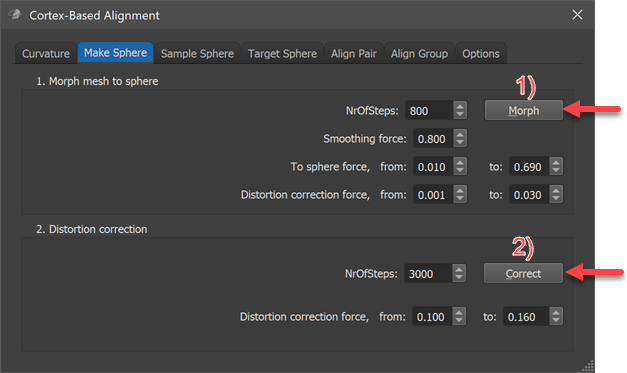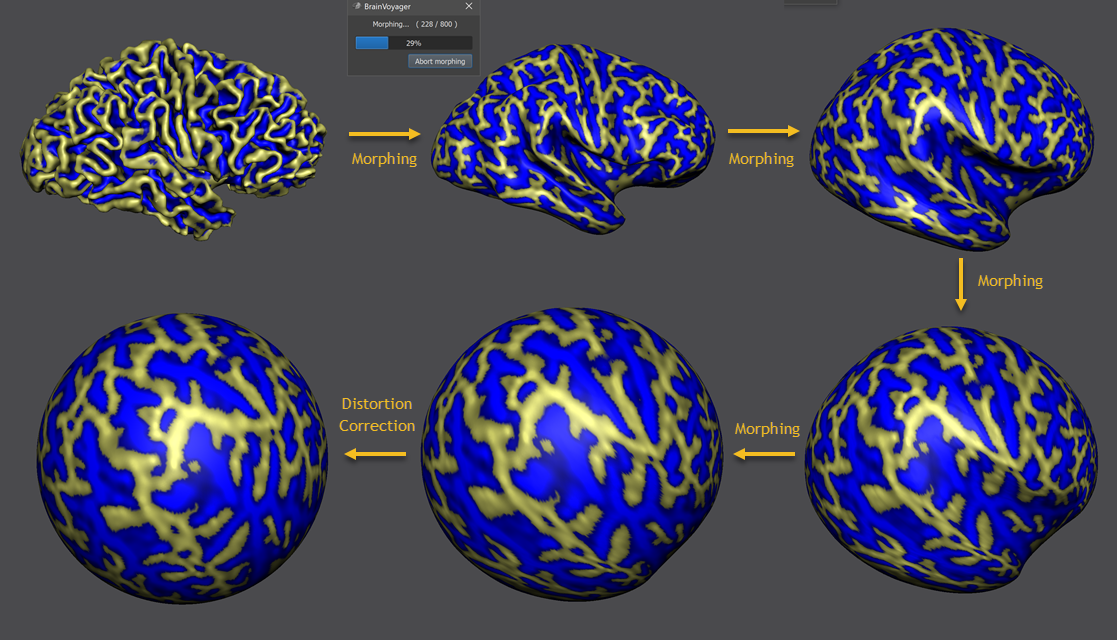BrainVoyager v23.0
Morphing a Reconstructed Cortex Hemisphere to a Sphere
The next step after preparing a cortex hemisphere mesh consists in morphing to a sphere since the CBA algorithm works on spherical representations. The morphed spheres will be resampled from a generic sphere in the next step allowing to align cortex meshes in a common space. The folded original mesh is transformed into a spherical representation in two steps. The first step quickly morphs the mesh into a sphere but the result contains large geometric distortions, i.e. some parts of the cortex are substantially expanded while others are substantially compressed. These distortions are reduced in the second step using an interative process.
With the prepared hemisphere mesh of a subject created or loaded in the 3D Viewer, the first step is started by clicking the Morph button in the 1. Morph mesh to sphere field of the Make Sphere tab of the Cortex-Based Alignment dialog (step 1 in the screenshot below). This will start an iterative morphing process that uses several forces with values that will be changed gradually over time. A smoothing force is used to remove the gyri and sulci from the mesh, while a to-sphere force attempts to push the mesh vertices outward towards positions on a sphere. A distortion correction force (used more strongly in the second step) helps to avoid topographic errors. These forces must be coordinated in order to get the desired result without introducing any foldings and in a reasonable amount of time. The default number of morphing steps is 800, which will produce a sphere without folding if the default values for the Smoothing force, To sphere force and Unfolding correction force values are used. These values should be fine in almost all cases, but they can be changed if problems are observed.

The screenshot below (top middle panel) shows the state of the to-sphere morphing process after 228 iteration for a right hemisphere cortex mesh ("sub-04_RH_RECOSM.srf", top left panel). At this early stage, the smoothing force is working stronger than the to-sphere force in order to reduce the folding of the mesh. Note that the superimposed curvature information indicates the original folding pattern. The top right and bottom right panels in the screenshot below show the morphing process roughly after half of the morphing has been completed. At this stage the to-sphere force is getting stronger, which is apparent by an increasingly rounded shape of the mesh.

When the to-sphere morphing has been completed, the folded cortex mesh has been transformed in a spherical representation (bottom middle panel). There are, however, some parts, which are expanded - especially mid-lateral and mid-medial parts - and other parts, which are squeezed - especially frontal and occipital regions. In order to correct these distortions as much as possible, the second morphing step is performed, which is started by clicking the Correct button in the 2. Distortion correction field. The amount of the current mean distortion during this step is depicted in the status bar during morphing. The mean distortion value is obtained by averaging distortion values calculated for each vertex by comparing the current distance of a vertex to its neighbors with the distance values when the mesh was in the original folded state. You will observe that the displayed mean linear distortion value will decline most of the time but it will sometimes also jump to higher values because the distortion correction process uses a "push-relax" approach. The NrOfSteps value is set to a value of 3000, which is normally sufficient to reduce distortions until a plateau is reached where no substantial progress is made. The value set in the to field of the Distortion correction force is set to a value, which ensures that the process will run successfully in most cases; if this force is set to a too hgih value, the mesh might "explode" since neighboring vertices are then moved too fast leading to folds in the mesh. The bottom-left panle in the snapshot above shows the mesh after the distortion correction morphing step has completed; when comparing this state with the sphere in the bottom middle panel at the end of the to-sphere morphing step, it can be seen that the expanded mid-lateral part (around the sylvian fissure) has been corrected substantially by reducing the vertex-to-vertex distances in this region.
After the distortion step is completet, the program automatically presents a Save As File dialog with a suggested name to store the resulting sphere mesh; the suggested name uses the original name but replaces the "_RECOSM" with a "_SPHERE" substring (in the example: "sub-04_RH_SPHERE.srf") allowing to easily identify from the file name that it contains a sphere as a result of morphing the original folded cortex mesh. After creation of the spherical representation, the next step can be perfomred that samples the created sphere from a standard sphere, which is subsequently used during intersubject alignment.
Copyright © 2023 Rainer Goebel. All rights reserved.